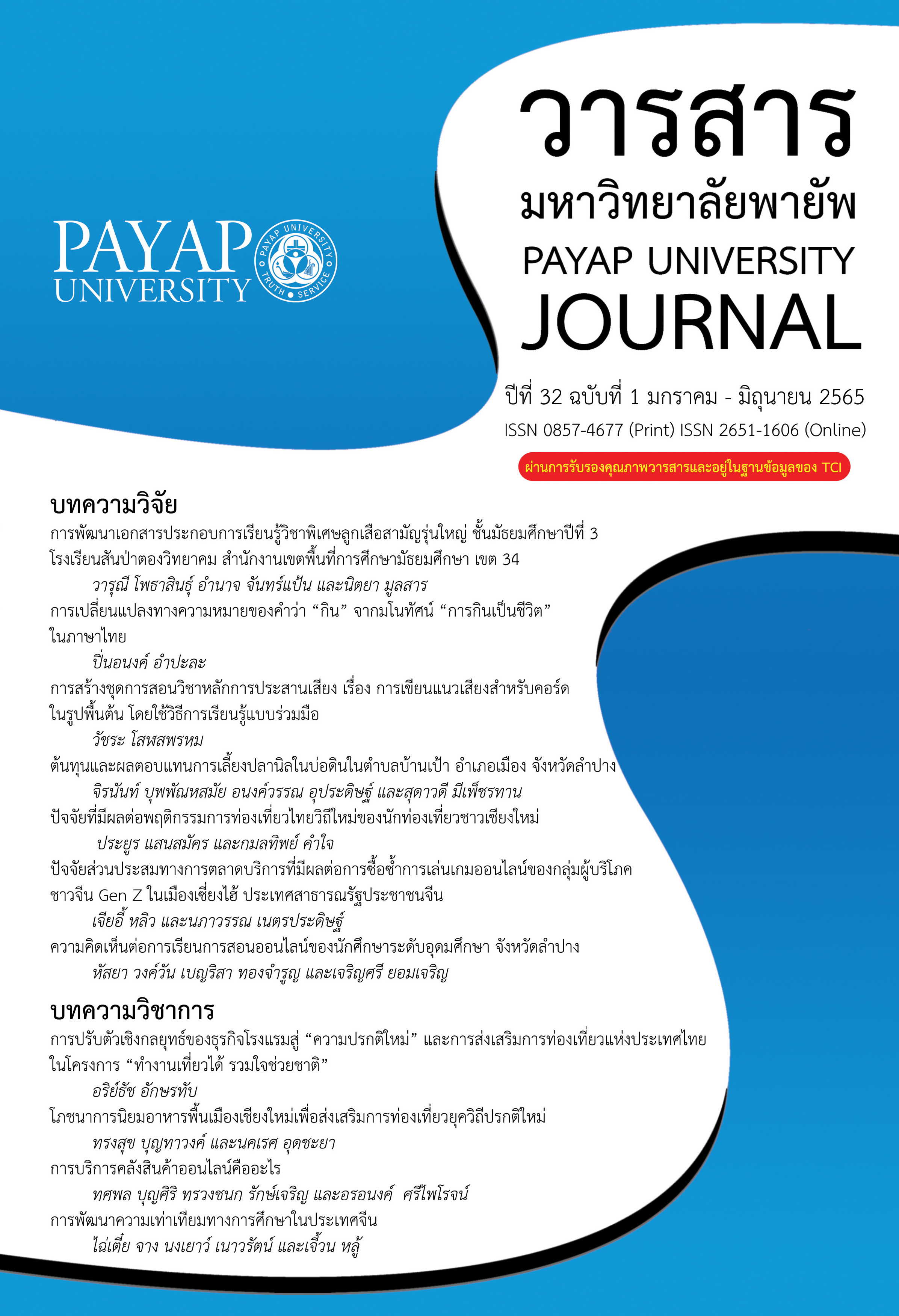การเปลี่ยนแปลงทางความหมายของคำว่า “กิน” จากมโนทัศน์ “การกินเป็นชีวิต” ในภาษาไทย
Main Article Content
บทคัดย่อ
“การกินเป็นชีวิต” แสดงจากกระบวนการเชื่อมโยงทางความคิดตามกระบวนการทางปริชานของมนุษย์ บทความวิจัยเรื่องนี้จึงมีจุดมุ่งหมายเพื่อวิเคราะห์การเปลี่ยนแปลงทางความหมายของคำว่า “กิน” และปัจจัยที่มีผลต่อการเปลี่ยนแปลงทางความหมายของคำว่า “กิน” จากมโนทัศน์ “การกินเป็นชีวิต” ที่ปรากฏในนวนิยายไทย โดยศึกษาจากนวนิยายไทยซึ่งเขียนและตีพิมพ์เผยแพร่ตั้งแต่ปี พ.ศ. 2447 จนถึงปี พ.ศ. 2562 ด้วยทฤษฎีภาษาศาสตร์ปริชานในประเด็นเกี่ยวกับมโนทัศน์ อุปลักษณ์ มโนทัศน์ และการเปลี่ยนแปลงทางความหมาย
ผลการวิจัยพบว่า การเปลี่ยนแปลงทางความหมายของคำว่า “กิน”จากมโนทัศน์ “การกินเป็นชีวิต” แสดงให้เห็นถึง วิถีชีวิต ความเป็นอยู่ พฤติกรรม แสดงมโนทัศน์ของผู้ใช้ภาษาและสรรพสิ่งที่เกี่ยวข้องกับชีวิตของมนุษย์ การเปลี่ยนแปลงทางความหมายดังกล่าว แสดงความหมายทั้งในด้านความหมายเชิงบวก ความหมายเชิงลบ ส่วนปัจจัยที่ส่งผลต่อการเปลี่ยนแปลงทางความหมายของ “การกินเป็นชีวิต” มีความสัมพันธ์กับการรับเอาวัฒนธรรมตะวันตกเข้ามาเป็นส่วนหนึ่งของชีวิต เช่น ค่านิยมการทดลองใช้ชีวิตคู่ การมีเพศสัมพันธ์ก่อนแต่งงาน เป็นต้น ดังนั้น การศึกษาการเปลี่ยนแปลงทางความหมายจากมโนทัศน์ดังกล่าว จึงเป็นหลักฐานด้านการศึกษาด้วยกระบวนการคิดอย่างหนึ่งที่สะท้อนให้เห็นระบบความคิดของผู้ใช้ภาษา
Article Details
เอกสารอ้างอิง
ก.สุรางคนางค์, นามแฝง. (2480). หญิงคนชั่ว. กรุงเทพฯ: ณ บ้านวรรณกรรม.
โกลาบ จัน. (2561). ไต้ฝุ่น. กรุงเทพฯ: แพรว.
ครูเหลี่ยม, นามแฝง. (2458). ความไม่พยาบาท. กรุงเทพฯ: ปูชนีย์.
คึกฤทธิ์ ปราโมช, ม.ร.ว. (2494). สี่แผ่นดิน, เล่ม 2. กรุงเทพฯ: นานมีบุ๊คส์.
จิ้ง เสิ่น, เมธาวี ยุทธพงษ์ธาดา และรุจิรา เส้งเนตร. (2562). การเปรียบเทียบการขยายความหมายของคำว่า “กิน” ในคำประสมที่เป็นรูปแบบคำกริยา + การใช้ภาษาไทยและภาษาจีน. มนุษยสังคมสาร, 17(1),67 – 84.
จุฬามณี, นามแฝง. (2560). กรงกรรม. กรุงเทพฯ: แสงดาว.
นันทนา วงษ์ไทย. (2561). ภาษาและความหมาย. กรุงเทพฯ: โรงพิมพ์ เค.ซี.อินเตอร์เพรส.
โบตั๋น, นามแฝง. (2524). ผู้หญิงคนนั้นชื่อบุญรอด. กรุงเทพฯ: สุวีริยาสาส์น.
ปราณี กุลละวณิชย์, กัลยา ติงศภัทิย์, ม.ร.ว. , สุดาพร ลักษณียนาวิน และอมรา ประสิทธิ์รัฐสินธุ์ และ. (2545). ภาษาทัศนา (พิมพ์ครั้งที่ 5). กรุงเทพฯ: โครงการตำราคณะอักษรศาสตร์ จุฬาลงกรณ์มหาวิทยาลัย.
ยุวดี ตันสกุลรุ่งเรือง (2550). รอยวสันต์. กรุงเทพฯ: ประพันธ์สาส์น.
ราชบัณฑิตยสถาน. (2556). พจนานุกรมฉบับราชบัณฑิตยสถาน พ.ศ. 2554 เฉลิมพระเกียรติพระบาทสมเด็จพระเจ้าอยู่หัวเนื่องในโอกาสพระราชพิธีมหามงคลเฉลิมพระชนมพรรษา 7 รอบ 5 ธันวาคม 2544. กรุงเทพฯ: ผู้แต่ง.
รุจิวรรณ เหล่าไพโรจน์. (2560). การศึกษาคำหลายความหมายคำว่า ăn “กิน” ในภาษาเวียดนาม: การศึกษาตามแนวภาษาศาสตร์ปริชาน. ภาษาและวัฒนธรรม, 36(2), 29 – 44.
ศรีบูรพา, นามแฝง. (2480). ข้างหลังภาพ. กรุงเทพฯ: ดอกหญ้า.
ศรีวรา ผาสุขดี. (2561). ปรากฏการณ์พหุนัยของชุดกริยาเคลื่อนที่ด้วยเท้าในภาษารัสเซีย: การศึกษาตามแนวภาษาศาสตร์ปริชาน. วิทยานิพนธ์ปรัชญาดุษฎีบัณฑิต มหาวิทยาลัยธรรมศาสตร์.
สิริวัฒน์ คำวันสา. (2539). สะท้อนวัฒนธรรมไทย, เล่ม 2. กรุงเทพฯ: ศูนย์พัฒนาหนังสือ กรมวิชาการ.
อากาศดำเกิง รพีพัฒน์, ม.จ. (2472). ละครแห่งชีวิต. กรุงเทพฯ: แพรว.
Arlotto, A. (1972). Introduction to historical linguistics. Lankam, Md.: University Press of America.
Evans, V. & Green, M. (2006). Cognitive linguistics: An introduction. Edinburgh: Edinburgh University Press.
Hui, L. X. & Park, K. E. (2019). A Cognitive Linguistic Study on the Polysemous Verb “KIN (‘to eat’)” in Thai. 한국태국학회논총 (Korea Association of Thai Studies), 25(2), 31 – 64, Retrieved August 9, 2020. from http://www.kci.go.kr/kciportal/landing/article.kci ?arti_id=ART002442045
Lakoff, G. & Johnson, M. (2003). Metaphors we live by. Chicago: The University of Chicago Press.
Ogden, C.K. & Richards, I. A.. (1972). The meaning of meaning: A study of the influence of language upon thought and of the science of symbolism. London: Routledge & Kegan Paul.
Unchalee Singnoi. (2006). Eating Terms: What the Category Reveals about the Thai Mind. MANUSYA, 9(1), 82 – 109.


